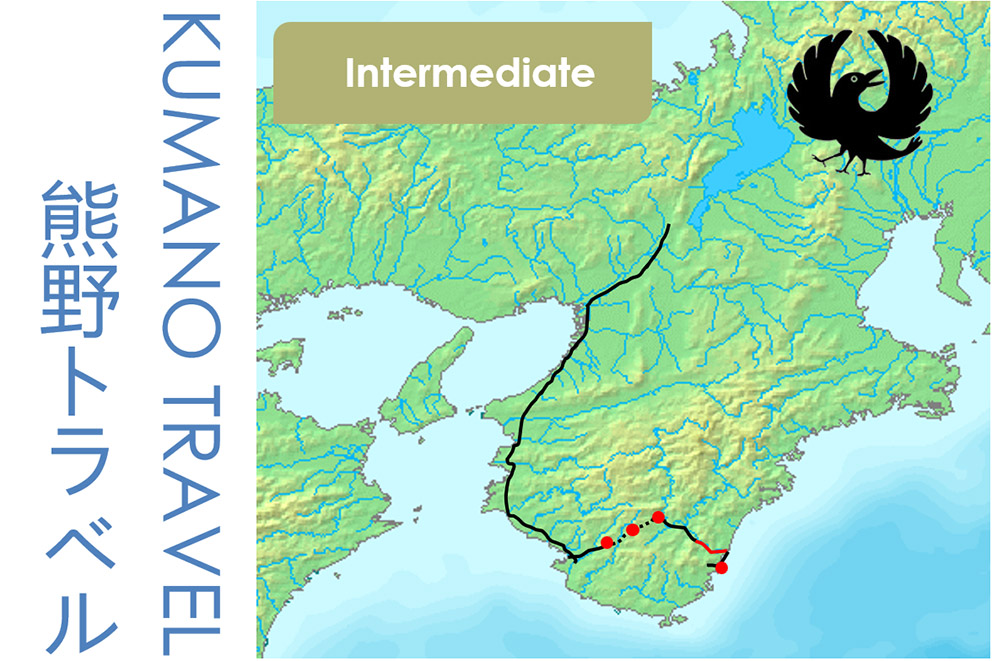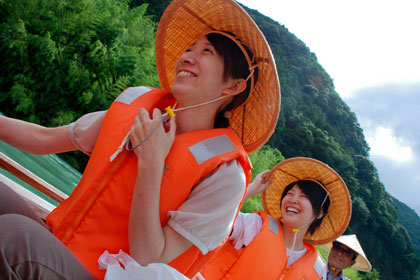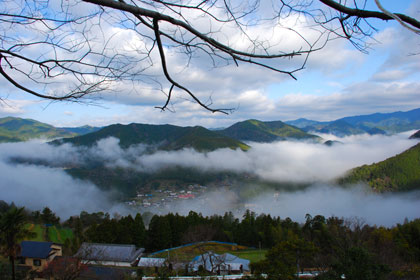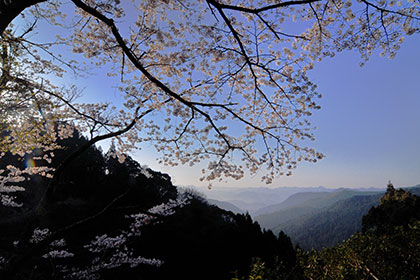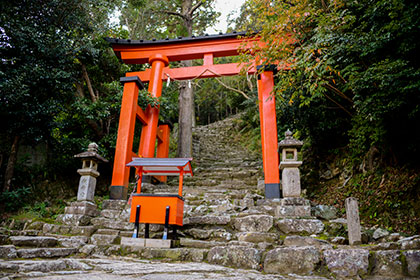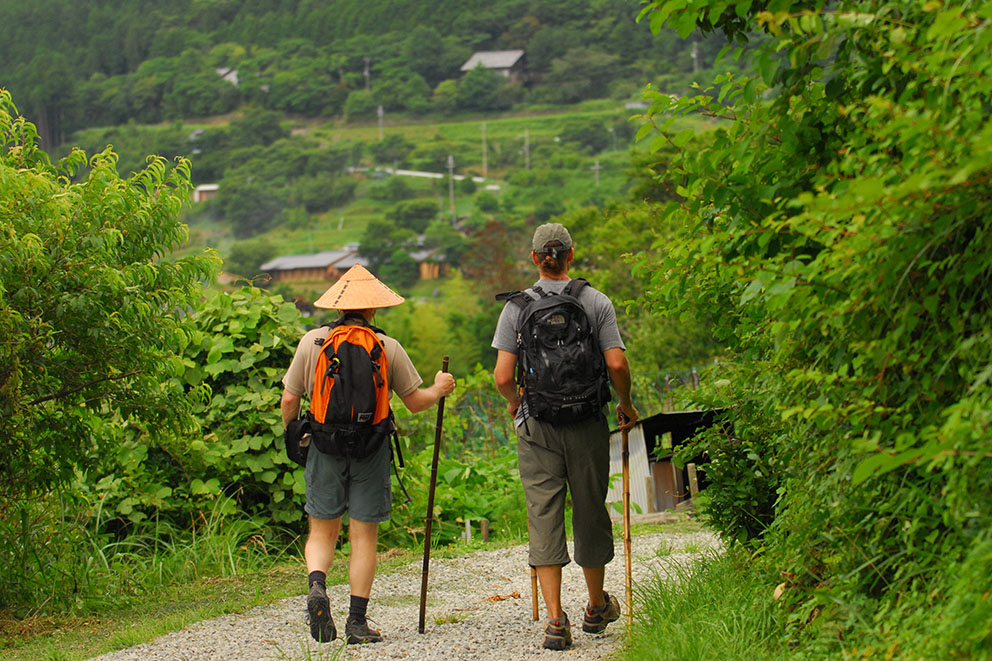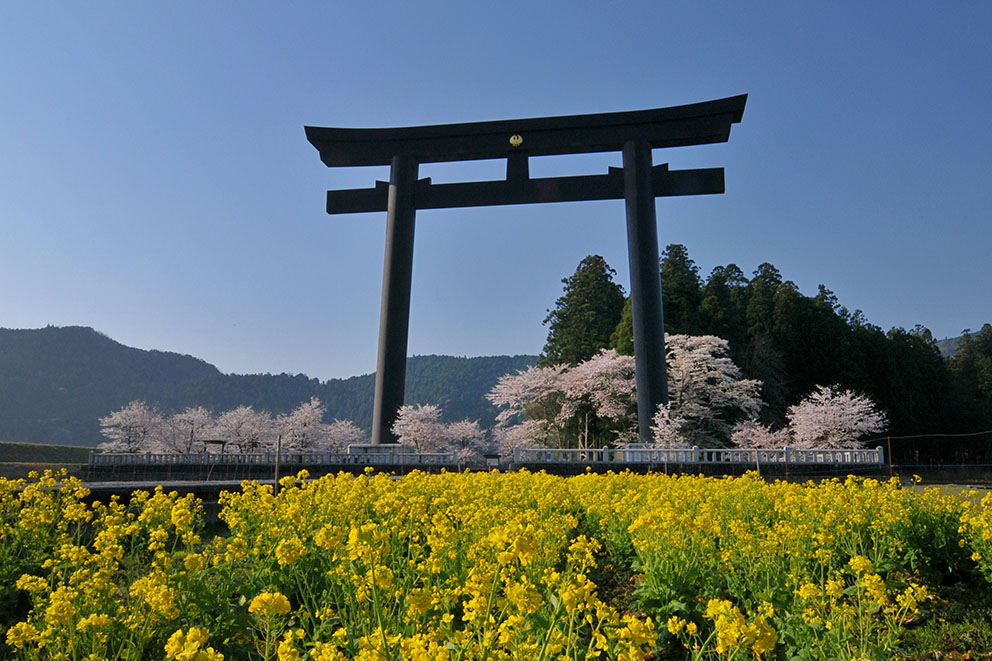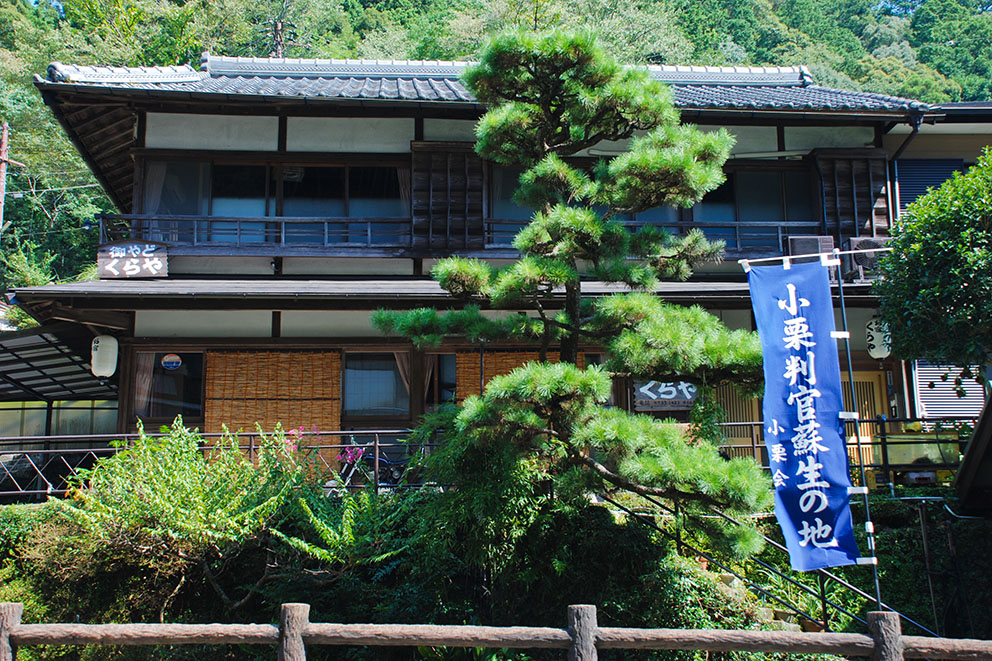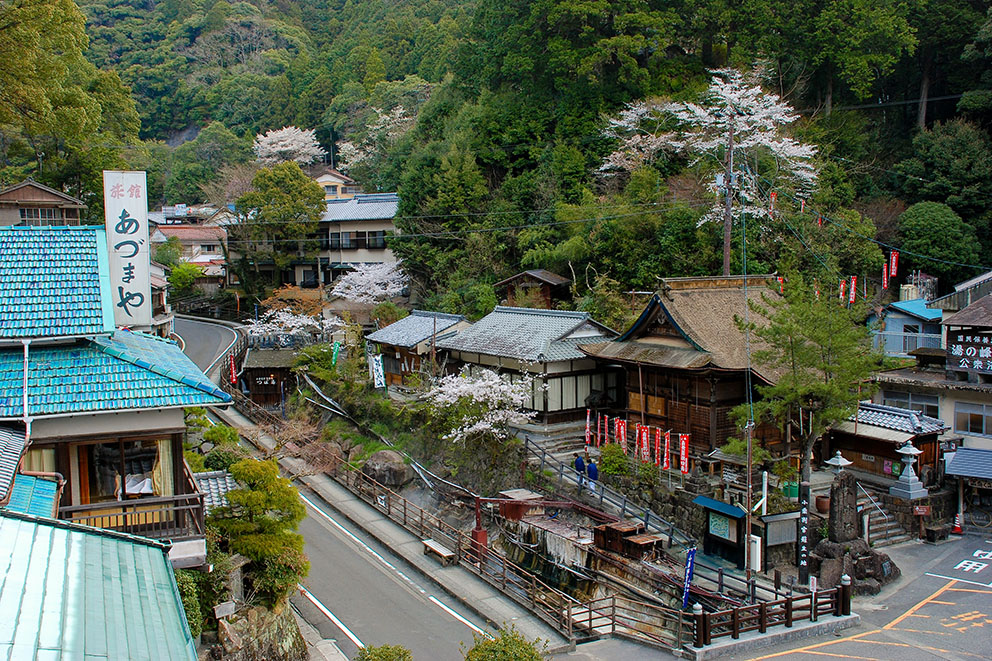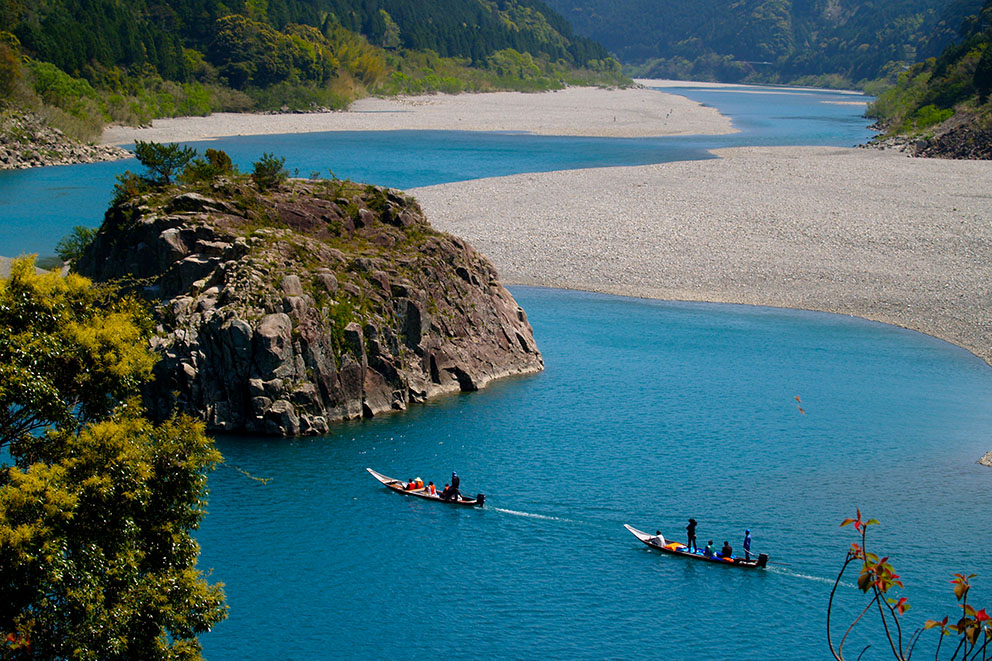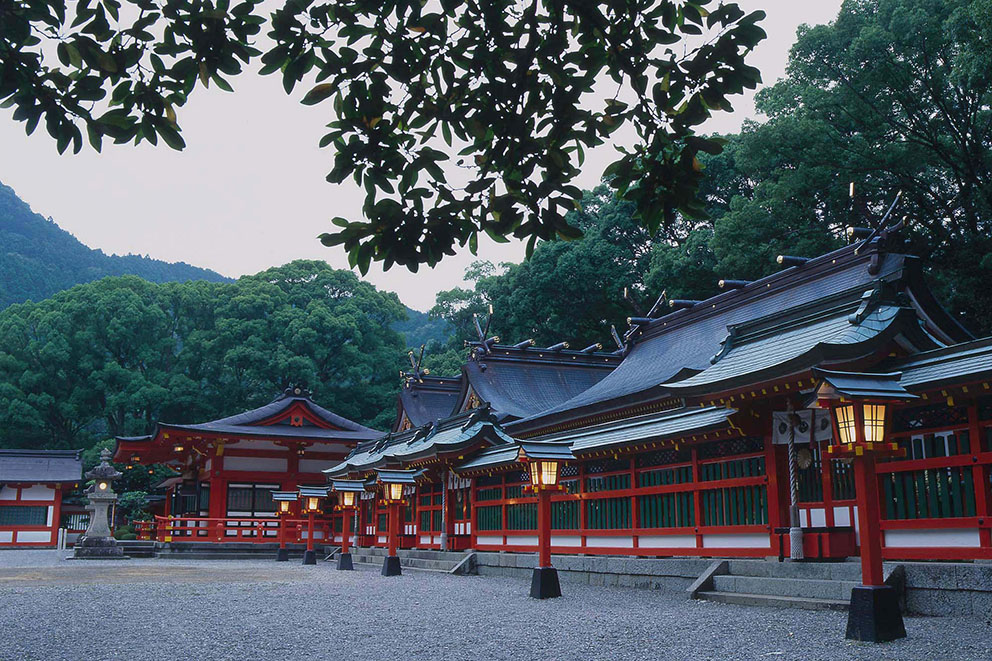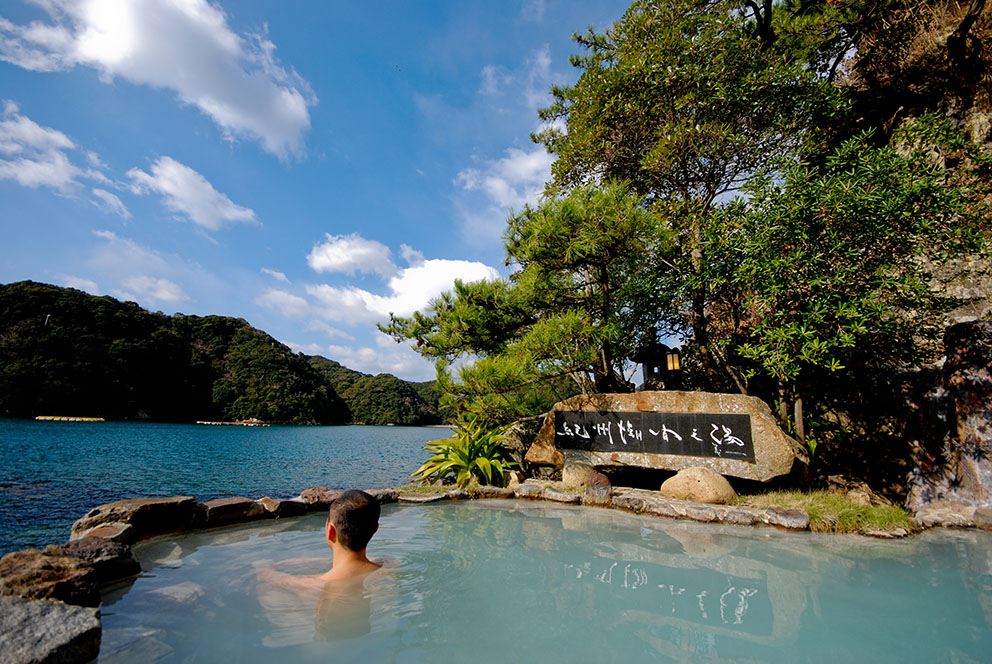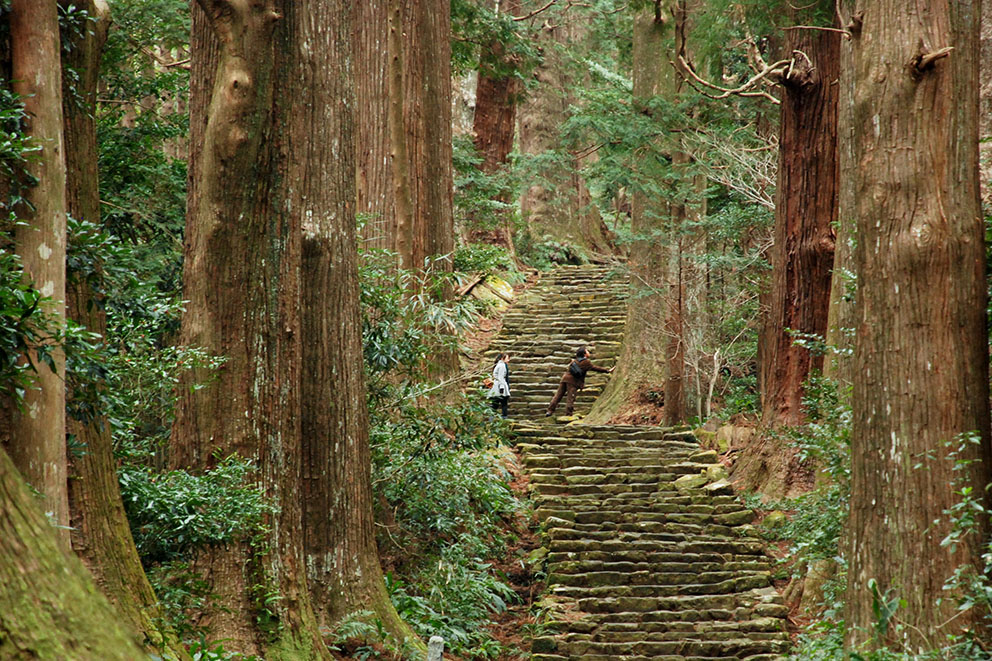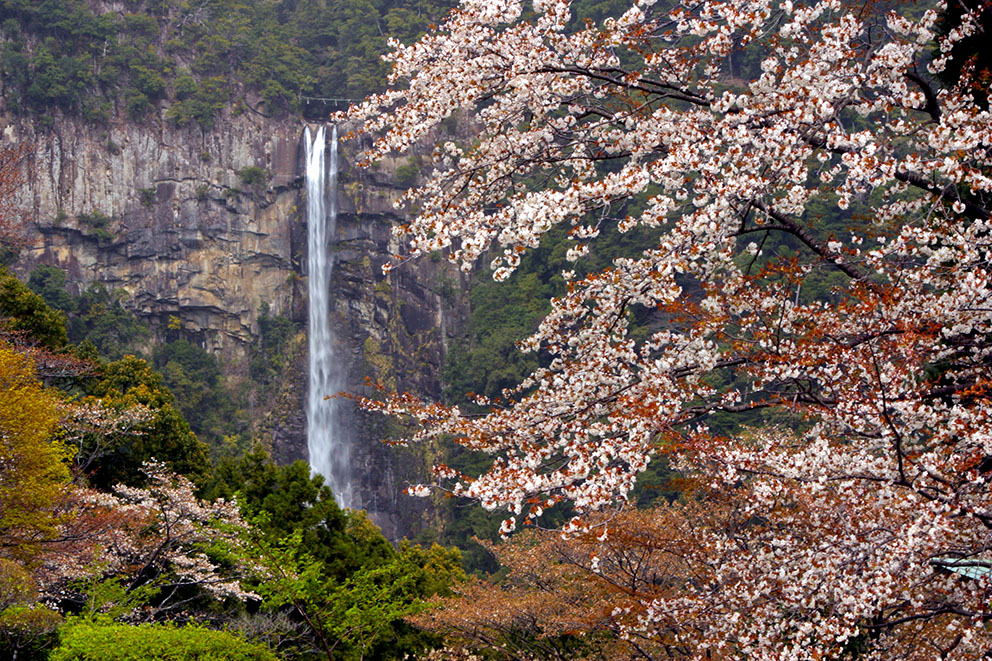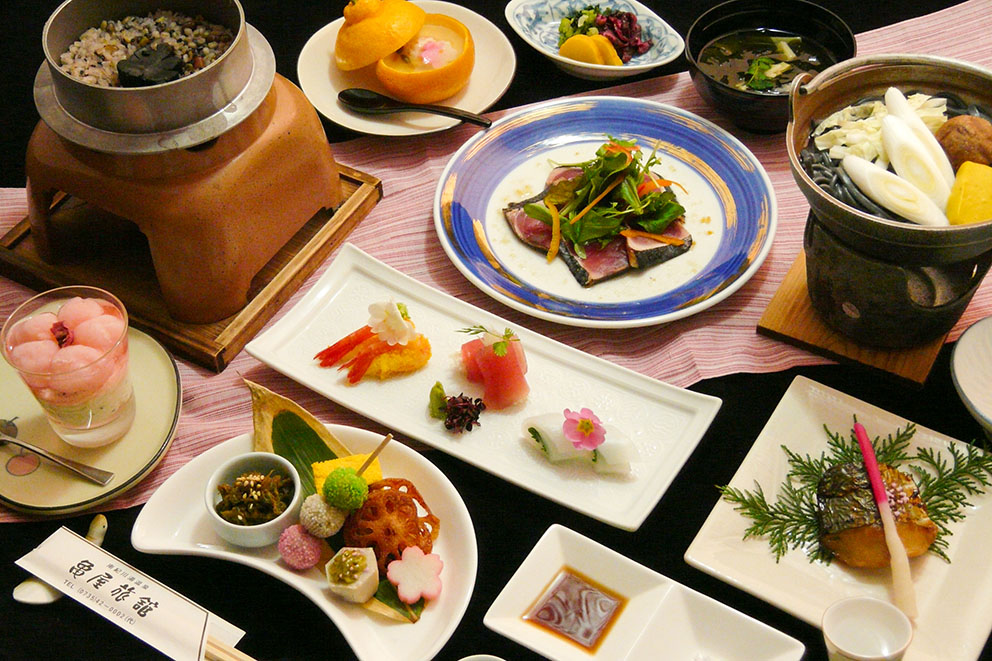KUMANO KODO Trek - 5 days | Nakahechi, Takijiri to Hongu, Shingu & Nachi
Rating & Reviews
4.8
Description
This itinerary included a variety of experiences related to the ancient Kumano pilgrimage.
There are some walks on the main portion of the Nakahechi pilgrimage, a visit to all three Kumano Grand Shrines, a trip on a traditional boat, and a few nights in onsen villages to enjoy the hot springs.
There is a diversity of walks: a bit of challenge (first two days) with some steeper climbs and descents (without being exhausting!) and easier highlight walks around the shrine areas (last 3 days).
Route: Kyoto/Osaka | Tanabe | Takahara | Chikatsuyu | Hongu | Yunomine Onsen | Shingu | Katsuura | Nachi | Osaka/Kyoto
Duration: 5 days & 4 nights (all 5 days have walks)
Overnight: Takahara, Chikatsuyu, Yunomine Onsen, Katsuura
Overall Level: Intermediate
Type: Self-guided or guided
Transportation: Train, Bus, Walk
Daily Luggage Shuttle: Available for all days
Walking Difficult: Day 1=2.5, Day 2=3, Day 3=2, Day 4=1.5, Day 5=1.5
What is walking difficulty?
Recommended For: Those who are good walkers looking for a bit of challenge (first two days), but also highlight walks (last 3 days)
| WHAT IS A MODEL ITINERARY? Model Itineraries are sample travel plans to help you organize your trip, an easy way to add contents to your cart that match your itinerary. These are not package tours. You can use them as they are, adjust them to your needs, or contact us for more ideas. |
|---|
| PRICE Price depends on which accommodations and services you book. All prices are online for your reference. |
|---|
- DAY 1
-
Train from Kyoto/Osaka to Kii-Tanabe (3 hrs)
Bus from Kii-Tanabe to Takijiri (~40 min)
Walk Takijiri-oji to Takahara (3.7 km, ~2.5 hrs)
Stay in Takahara
- DAY 2
-
Walk Takahara to Chikatsuyu-oji (9 km, 5~6 hrs)
Stay in Chikatsuyu
- DAY 3
-
Bus from Chikatsuyu to Hongu (~30 min)
Bus from Hongu to Hosshinmon-oji (~15 min)
Walk Hosshinmon-oji to Kumano Hongu Taisha (~7 km, ~3 hrs)
Bus from Hongu to Yunomine Onsen (~20 min) or walk (~2 km, 1~2 hr)
Stay in Yunomine Onsen
- DAY 4
-
Bus from Hongu to Michi-no-Eki Kumanogawa (~30 min)
Boat tour to Shingu (~1 hr 30 min)
Bus/train from Shingu to Katsuura (~40 min or less)
Stay in Katsuura Onsen
- DAY 5
-
Bus from Kii-Katsuura Station to Daimon-zaka (~10 min)
Walk Daimon-zaka to Kumano Nachi Taisha (total ~2.5 km, ~2 hrs)
Bus from Nachisan to Kii-Katsuura (~20 min)
Train from Kii-Katsuura to Shin-Osaka (~3 hr, 50 min)
Itinerary Map
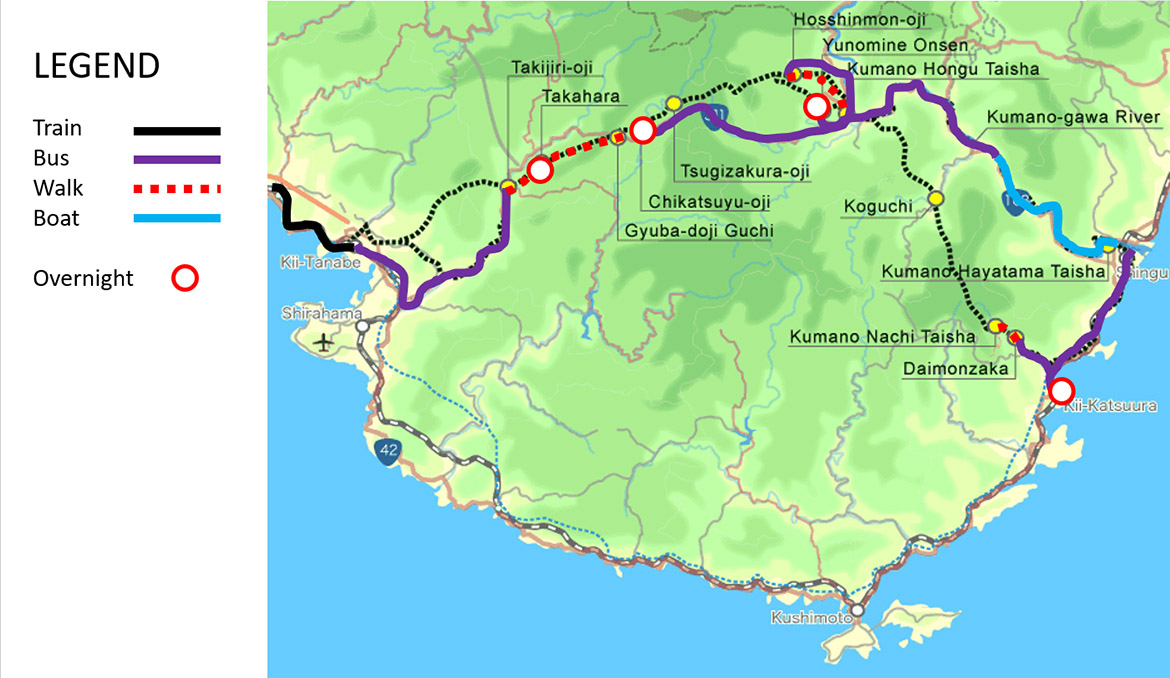
Detailed Itinerary
BEFORE YOUR TRIP
-
PREPARATION
Preparation and planning is the key to a safe trek in the sacred Kumano mountains.
Choose a route that you have adequate experience and physical strength to safely complete.
Wear appropriate clothing and footwear, and carry necessary gear.
NOTE: Details sometimes change, especially bus schedules, so please double-check times before your trip. If you notice something incorrect, please let us know. Thank you! -
WHEN TO VISIT
The Nakahechi route is open year round.
Summer can be hot and humid, and winter has a slight possibility of snow at higher elevations (from end of December to end of February) although it usually melts shortly it falls. The winter months have shorter daylight hours.
Japanese national holidays and long-weekends can be busy so best to avoid (especially golden week in the beginning of May and Obon mid-August).
NOTE: It is often best to come mid-week as capacity is limited in smaller villages along the trail.
-
RESOURCES
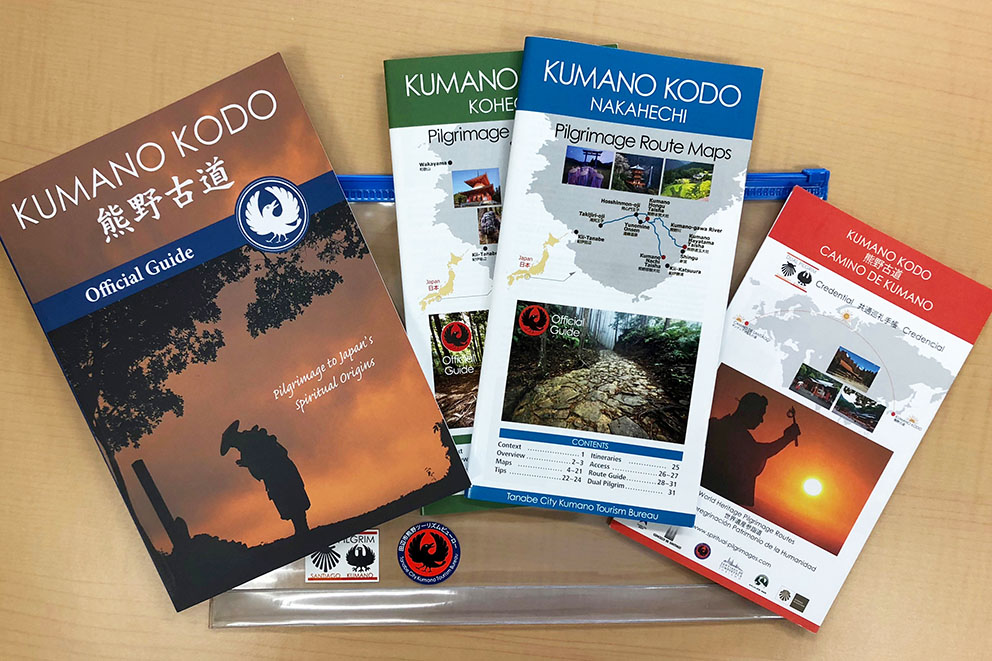 There are many useful resources related to the Kumano Kodo pilgrimage routes. Please use these to make the most of your trip.
There are many useful resources related to the Kumano Kodo pilgrimage routes. Please use these to make the most of your trip.
Maps and Official Guide Book, are available onsite in Tanabe. Online “Pilgrim Packs” including these materials can be mailed in advance. -
INCLUSIONS
The itinerary below is a sample.
Only the products and services that you book are included. For example if you would like lunch boxes or daily luggage shuttle, these must be reserved in advance. They are not included unless you book them.
Transportation fees are not included. It is easy to pay transport costs as you go. -
GUIDED or SELF-GUIDED
This model itinerary can be done guided or self-guided.
1. Self-guided. Use the detailed information online and onsite to complete your walk independently.
2. Guided. Hire a local guide to have some comradery on the trail while experiencing the region’s rich culture.
3. Partly-guided. Or have the best of both! Hire a guide for the first day to get you going and then complete the itinerary on your own.
NOTE: The itinerary below is based on option 1. Self-guided -
LUGGAGE OPTIONS
There are a few options for your luggage.
1. Daily Luggage Shuttle. Luggage is transferred to your accommodation everyday (This is often the most popular option. If required, please book when making your accommodation reservations).
2. Next-day or Later Luggage Shuttle can be arranged onsite without reservations at local convenience stores.
NOTE: The itinerary below is based on option 1. Daily Luggage Shuttle -
MEALS
Immersing oneself in local cuisine is part of the Kumano experience.
1. At Accommodations. Meals are most often served in accommodations in rural areas, as options for eating outside are limited to non-existent. (Eating the set meals at accommodations is the most common and convenient option.)
2. Lunch Boxes. Lunch boxes are provided by most accommodations along the Kumano Kodo (in the Hongu area can be delivered to your lodging in the morning).
3. Special Dietary Needs. Special meal requests such as vegetarian or specific allergies must be made at the time of booking. Vegetarianism is not common in Japan, especially in the countryside, so please double-check to confirm which types of vegetarian meals are available. Often being able to eat trace amounts of the ubiquitous Dashi fish stock makes it easier to find options.
NOTE: The itinerary below is based on meals supplied 1. At Accommodations with 2. Lunch Boxes when available.
DAY 1
Transfer to Tanabe & Takijiri, Walk Kumano Kodo
Overnight: Takahara
-
DAY 1 OVERVIEW
DAY ONE is a transfer to the trailhead at Takijiri-oji by train and bus, followed by a shorter but steep walk on the Kumano Kodo to the Takahara Settlement.
NOTE: The Kumano Kodo is a mountain trail, therefore walking times vary greatly depending on weather, season, personal experience, and fitness. Please plan accordingly for a safe walk, as many people underestimate the difficulty of the terrain. -
TRAIN FROM OSAKA TO KII-TANABE (JR Kuroshio 3)
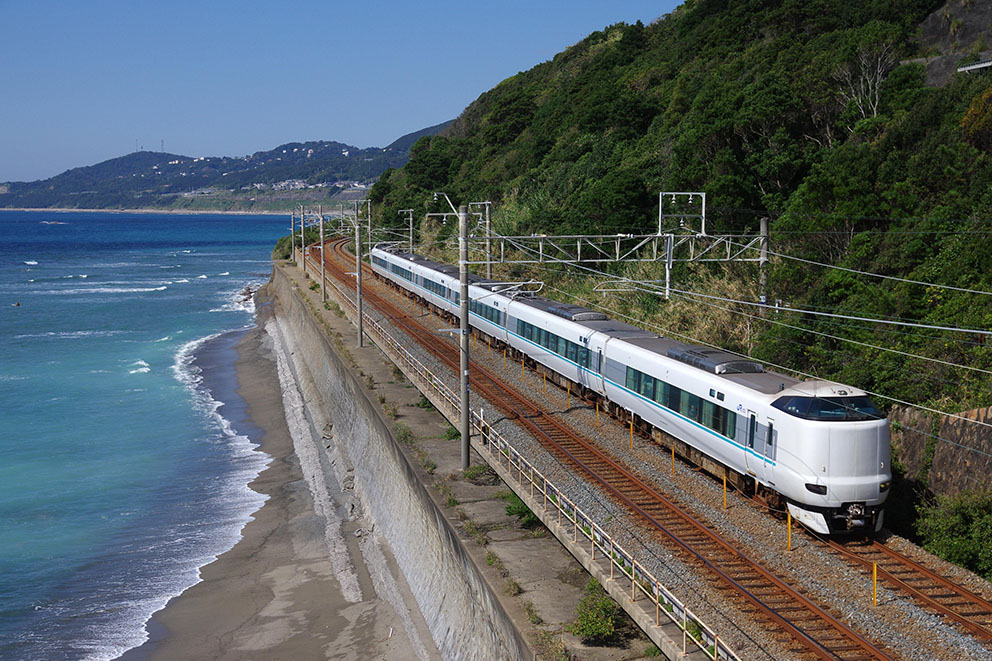
Depart: 8:58 Shin-Osaka
Depart: 9:19 TennojiArrive: 11:21 Kii-Tanabe
The JR train travels down the west coast of the Kii peninsula.
As you head south the scenery changes dramatically from the large urban centers to agricultural and natural regions, with distinctively less populated mountains.
Watch for terraced orange and ume orchards along the way.
TIP: Sit on the right hand side of the train for the best views.
-
VISIT TANABE TOURIST INFORMATION CENTER
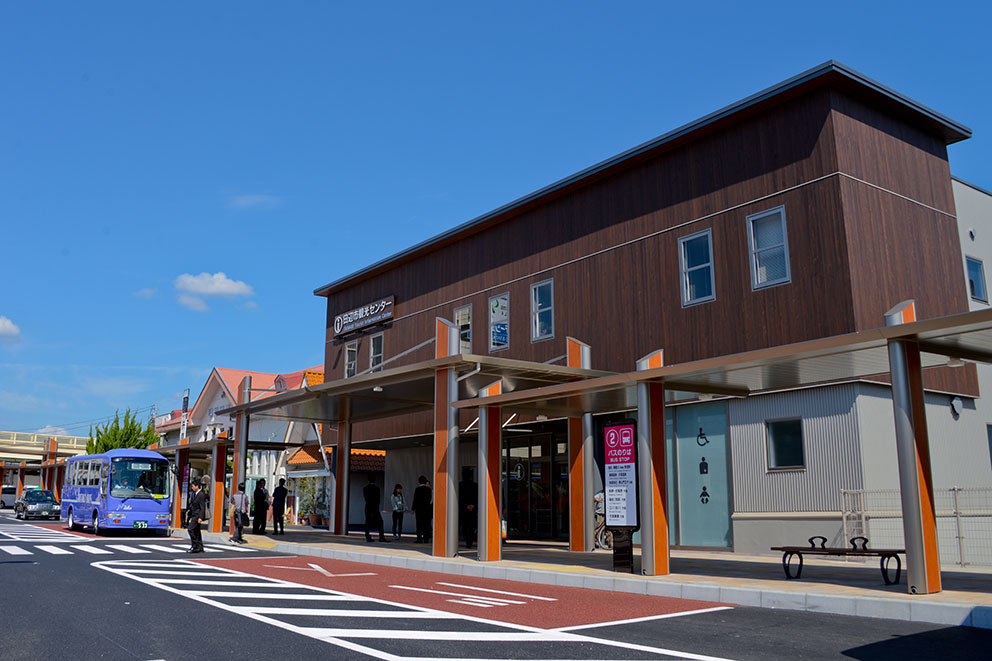
This information center is next to the Kii-Tanabe station as you exit on the left.
There are paper copies of maps and transportation timetables as well as Dual Pilgrim credential to collect stamps along the trail.
This is the best place to get the most up-to-date information before you begin your walk! -
LUGGAGE SHUTTLE
Give your bags directly to your reserved daily luggage service provider outside of the TANABE Tourist Information Center to be delivered to your accommodation.
TIP: Daily luggage shuttle is convenient and highly recommended: to be able to walk freely without the worry of your bags. -
MEALS
At a restaurant, or buy something to go. Ask at the tourist information center for ideas.
-
BUS FROM KII-TANABE STATION TO TAKIJIRI (Ryujin Bus)
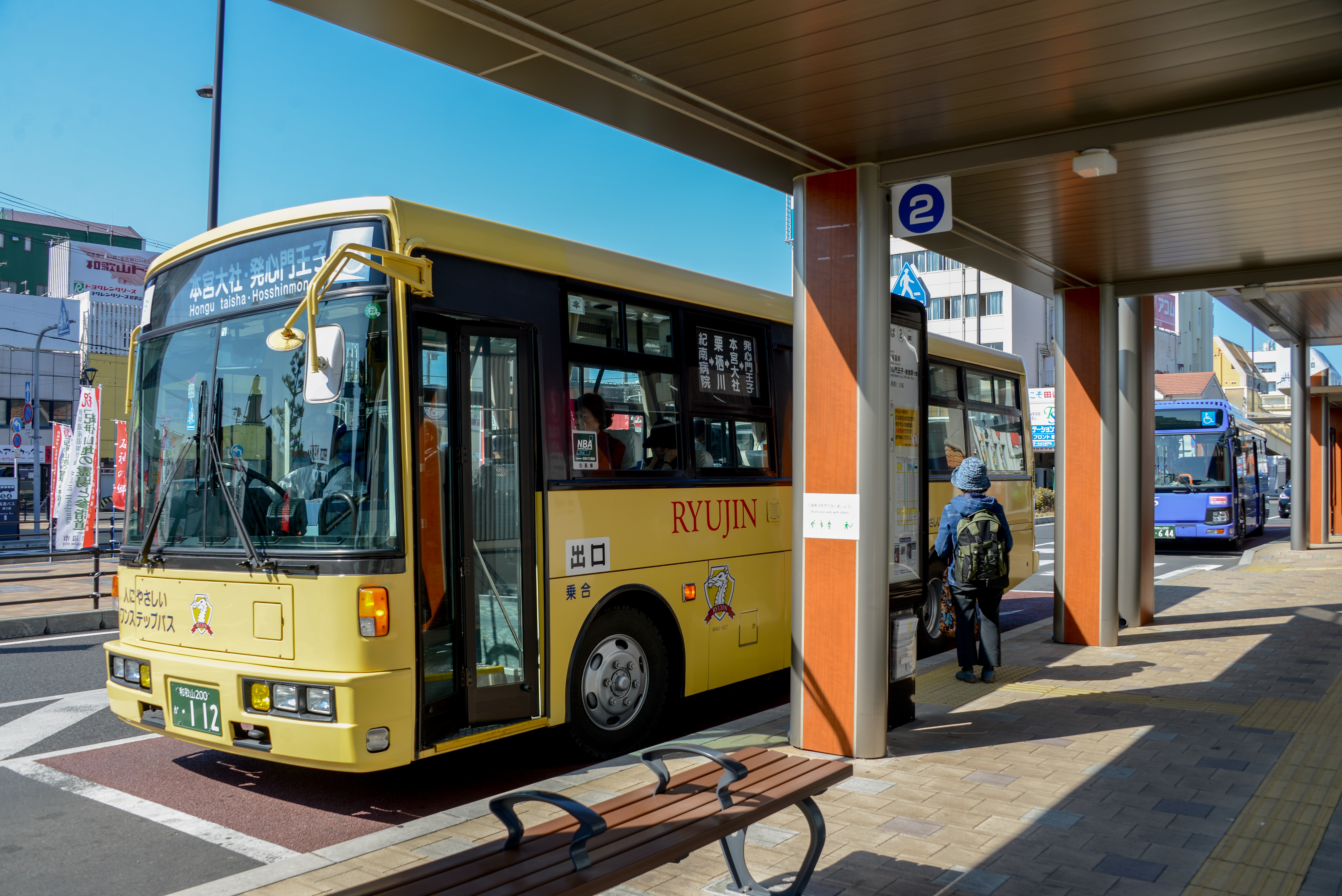
Depart: 12:50 Kii-Tanabe
Arrive: 13:28 Takijiri
Busses depart from bus stop # 2 in front of the station.
PRICE: 970 yen
NOTE: You can buy your bus ticket at the vending machine in the information center.
-
VISIT KUMANO KODO KAN PILGRIMAGE CENTER
The round Kumano Kodo Kan Pilgrimage Center is located across the river from Takijiri-oji.
There are introductory exhibitions in Japanese and English about the pilgrimage route.
Toilets and vending machines are available.
-
VISIT TAKIJIRI-OJI
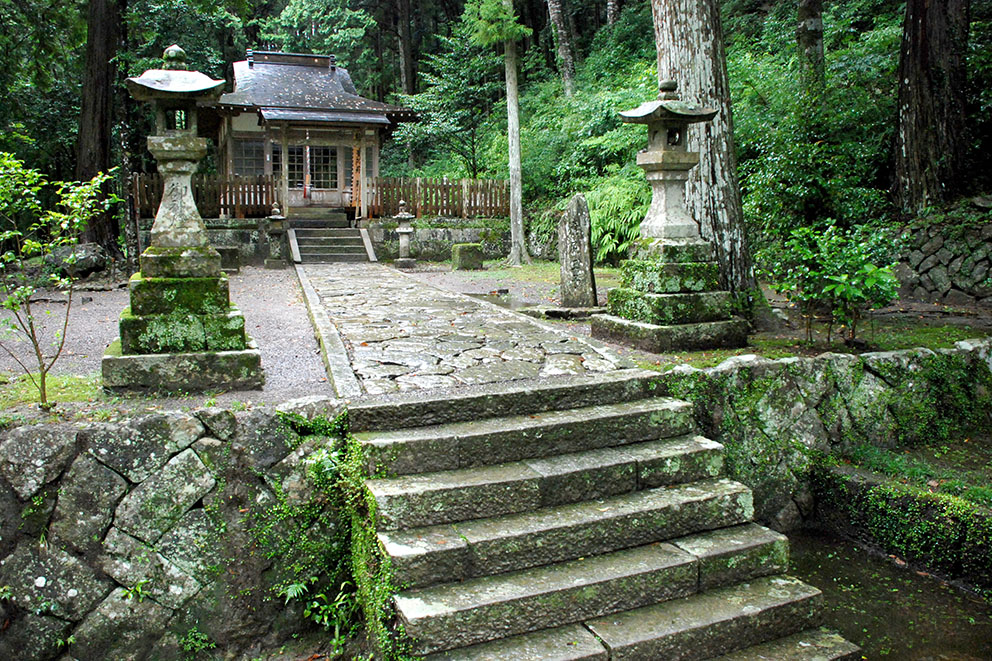 Takijiri-oji is one of the main trailheads of the Nakahechi route.
Takijiri-oji is one of the main trailheads of the Nakahechi route.
It is here that the passage into the sacred mountains begins—the entrance to the abode of the gods and Buddhist paradises of rebirth.
There were once extensive halls, a bath house, lodgings for pilgrims, and residences for priests, priestesses and monks in the area.
-
WALK KUMANO KODO - TAKIJIRI-OJI TO TAKAHARA
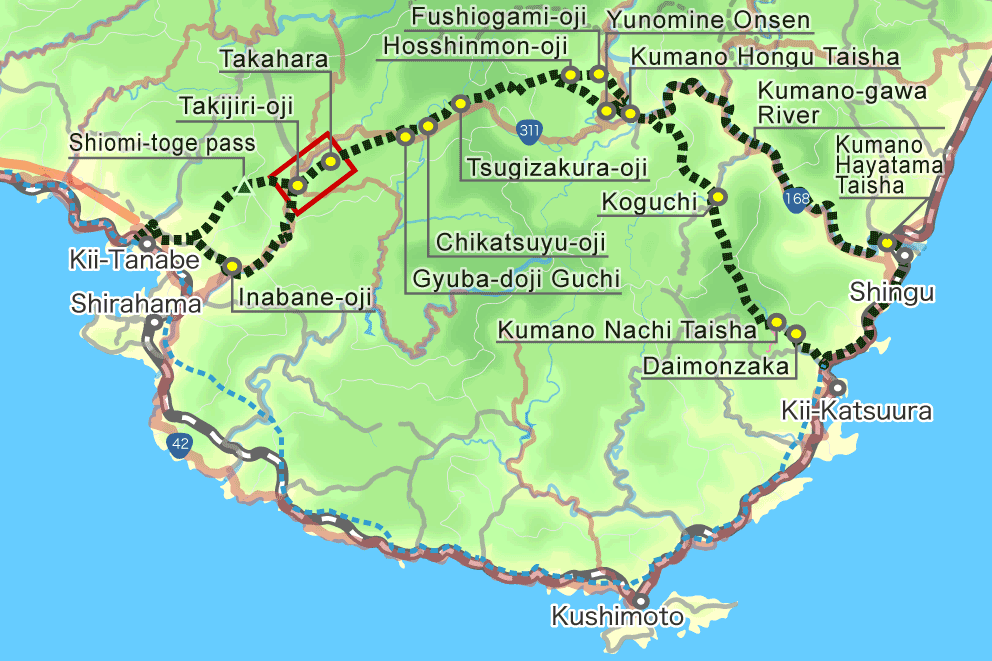
Distance: ~4 km
Time: 2~3 hr
Elevation Gain: ~430 m
Elevation Loss: ~200 m
This is a short but steep uphill walk from Takijiri to the ridge top settlement of Takahara. The trailhead is located behind the Takijiri-oji shrine pavilion.
NOTE: The trail starts off with a challenging grade so set a slow, easy pace, watching your steps on the rocks and roots. -
VISIT TAKAHARA
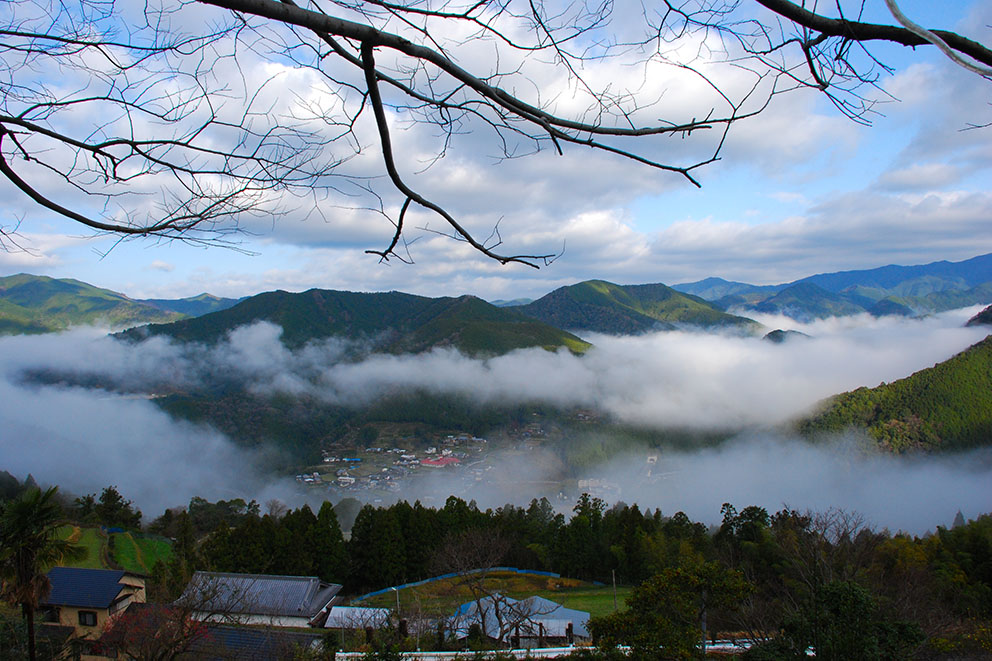 Takahara is a small settlement on a ridgeline with panoramic views of the Hatenashi mountain range.
Takahara is a small settlement on a ridgeline with panoramic views of the Hatenashi mountain range.
It is the site of the mystical Takahara Kumano-jinja shrine, one of the oldest buildings along this section of the pilgrimage route. The shrine grounds are home to giant camphor trees, over 800 years old!
Takahara is known as "Kiri-no-Sato" (Village in the Mist) because the scenic vistas are often blanketed with mist. The valley below dramatically fills with fog, creating a beautiful sea of clouds. -
OVERNIGHT IN TAKAHARA
There are a few options in Takahara including the Kiri-no-Sato Takahara Lodge and smaller facilities, such as rental houses.
-
SUPPER
At accommodation.
DAY 2
Walk Kumano Kodo, Takahara to Chikatsuyu
Overnight: Chikatsuyu
-
DAY 2 OVERVIEW
DAY TWO is a day walk on the Kumano Kodo from Takahara to Chikatsuyu village. -
BREAKFAST
At accommodation.
PICK UP LUNCH BOX
It is usually easiest to order your lunch box from the accommodation. Book a lunch box plan to take advantage of this service. -
LUGGAGE SHUTTLE
Leave luggage at accommodation.
-
WALK KUMANO KODO - TAKAHARA TO CHIKATSUYU
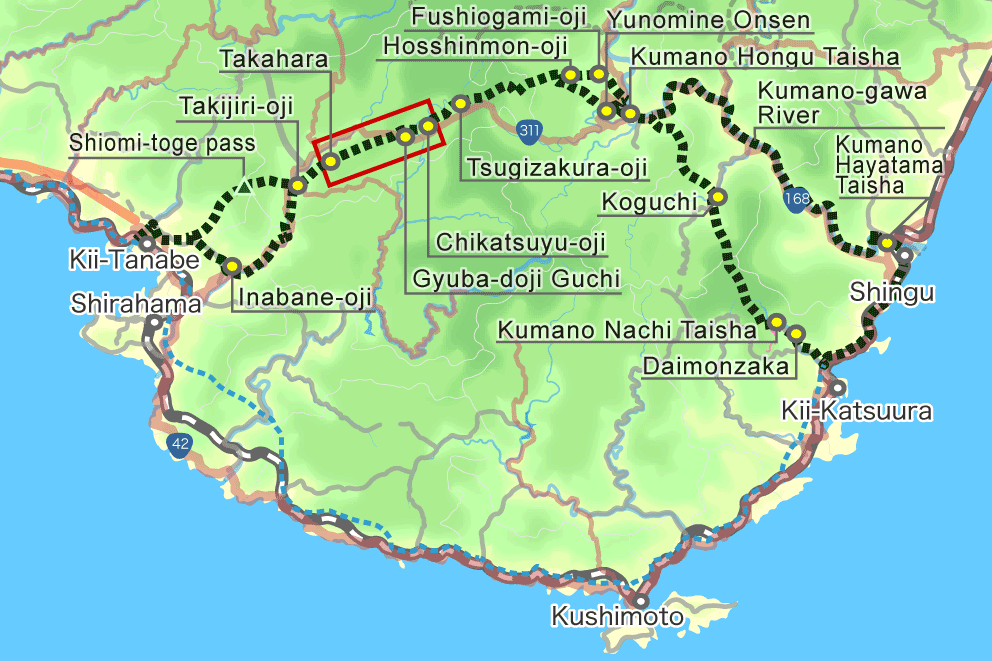
Distance: ~10 km
Time: 4~6 hr
Elevation Gain: ~590 m
Elevation Loss: ~640 m
This walk continues into the forested mountains east of Takahara climbing up and over ridges into the next watershed, descending into the village of Chikatsuyu.
NOTE: The Michi-no-Eki rest area near numbered signpost 23 sells drinks, snacks, and simple meals. -
LUNCH
Picnic lunch along the trail or at Michi-no-Eki rest area.
-
VISIT CHIKATSUYU
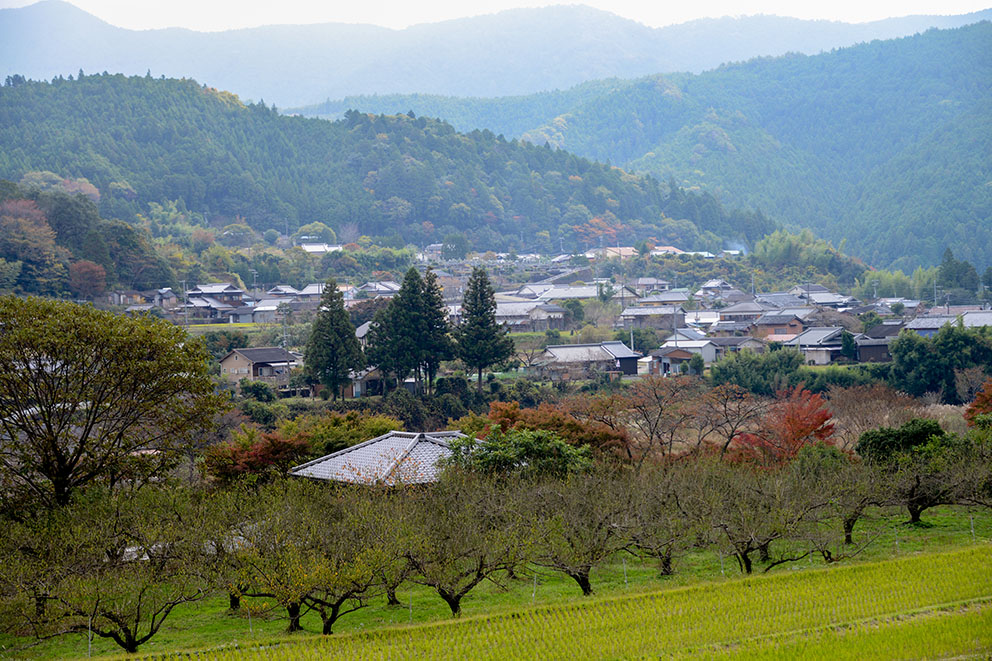 The village after Takahara is Chikatsuyu where the clear Hiki-gawa river runs through the valley.
The village after Takahara is Chikatsuyu where the clear Hiki-gawa river runs through the valley.
Pass through Chikatsuyu towards Tsugizakura-oji. -
OVERNIGHT IN CHIKATSUYU
There are some minshuku guesthouses and rental houses in Chikatsuyu.
-
SUPPER
At accommodation.
DAY 3
Walk Kumano Kodo, Hosshinmon-oji to Kumano Hongu Taisha
Overnight: Yunomine Onsen
-
DAY 3 OVERVIEW
Transfer by bus and walk the climax section of the Kumano Kodo. The trail from Hosshinmon-oji to Hongu is popular with a diversity of forested trail and settlement scenery.
Visit Kumano Hongu Taisha and Yunomine Onsen.
-
BREAKFAST
At accommodation.
PICK UP LUNCH BOX
It is usually easiest to order your lunch box from the accommodation. Book a lunch box plan to take advantage of this service. -
LUGGAGE SHUTTLE
Leave luggage at accommodation.
-
BUS FROM CHIKATSUYU TO HONGU (Meiko Bus)
Depart: 9:42 Nakahechi Bijutsukan (Nakahechi Museum)
Arrive: 10:12 Hongu Taisha-mae
PRICE: 1090 yen
NOTE: There is also a direct bus from Chikatsuyu to Hosshinmon-oji which departs earlier at 7:23.
-
BUS FROM HONGU TO HOSHINMON-OJI (Ryujin Bus)
Depart: 10:30 Hongu Taisha-mae
Arrive: 10:45 Hosshinmon-oji
PRICE: 470 yen
NOTE: Transfer at the same bus stop.
-
WALK KUMANO KODO - HOSSHINMON-OJI TO KUMANO HONGU TAISHA
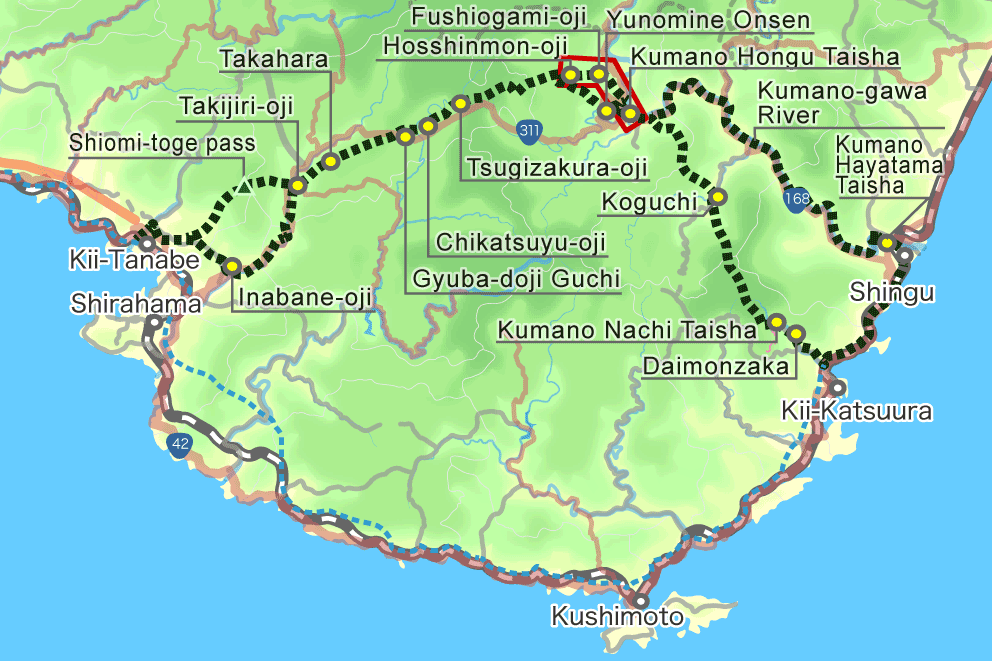
Distance: ~7 km
Time: 2~3 hr
Elevation Gain: ~190 m
Elevation Loss: ~460 m
This is a very nice half day walk on the Kumano Kodo pilgrimage route. It goes through a mixture of ridge top settlements and forest trails.
There are some good panoramic lookout spots along the trail. -
LUNCH
Picnic lunch along trail or at restaurant in Hongu.
-
VISIT KUMANO HONGU TAISHA
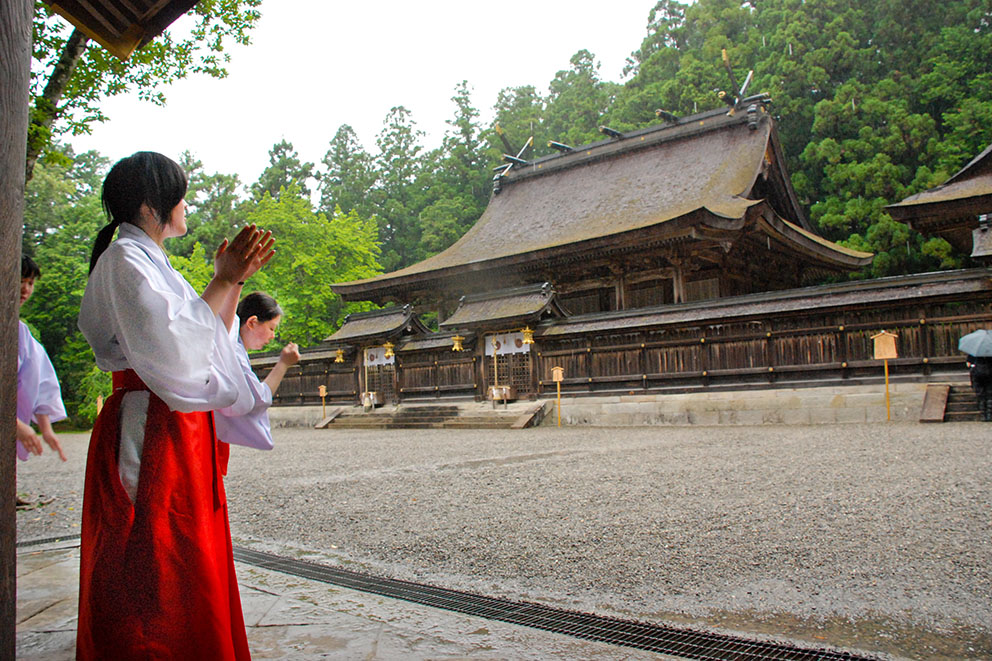
One of the three grand shrines, Kumano Hongu Taisha stands on a small ridge line in the north of the Hongu village.
The austere pavilions are made of wood with impressive cypress bark roofs; it's architecture style dating back over 800 years.
Watch for the sacred symbol of Kumano, the Yatagarasu three-legged crow.
-
VISIT KUMANO HONGU HERITAGE CENTER
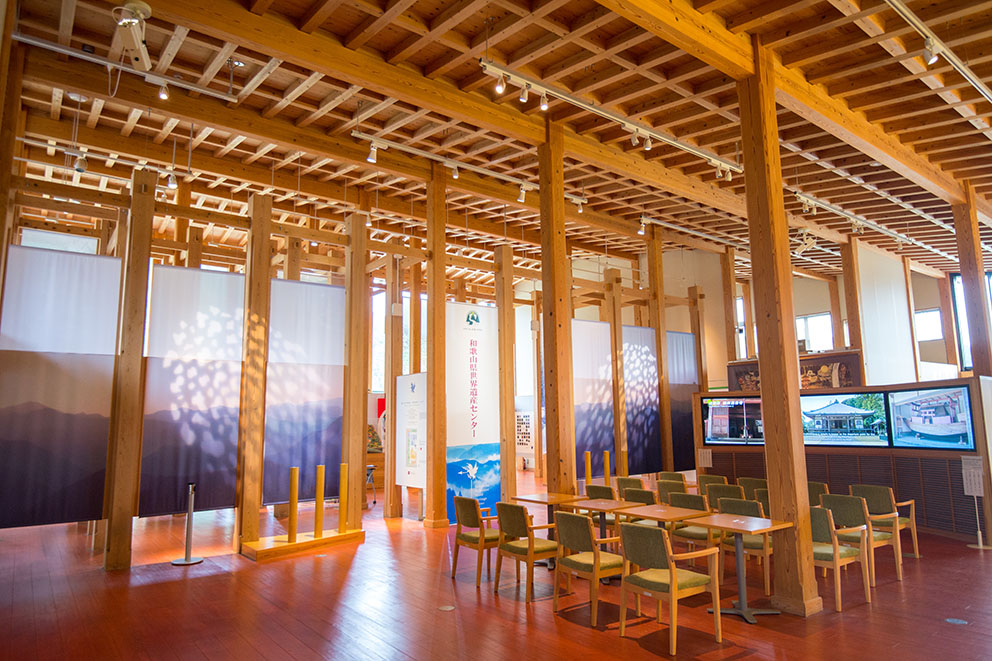
This visitor center is on the east side route 311 across from the Kumano Hongu Taisha grand shrine.
It has detailed information and exhibits about the area in English.
HOURS: 9:00~17:00 (open year-round)
NOTE: Registration as DUAL PILGRIM takes place here. It takes at least 15 minutes and cannot be mailed out.Kumano Hongu Heritage Center
Dual Pilgrim -
VISIT OYUNOHARA
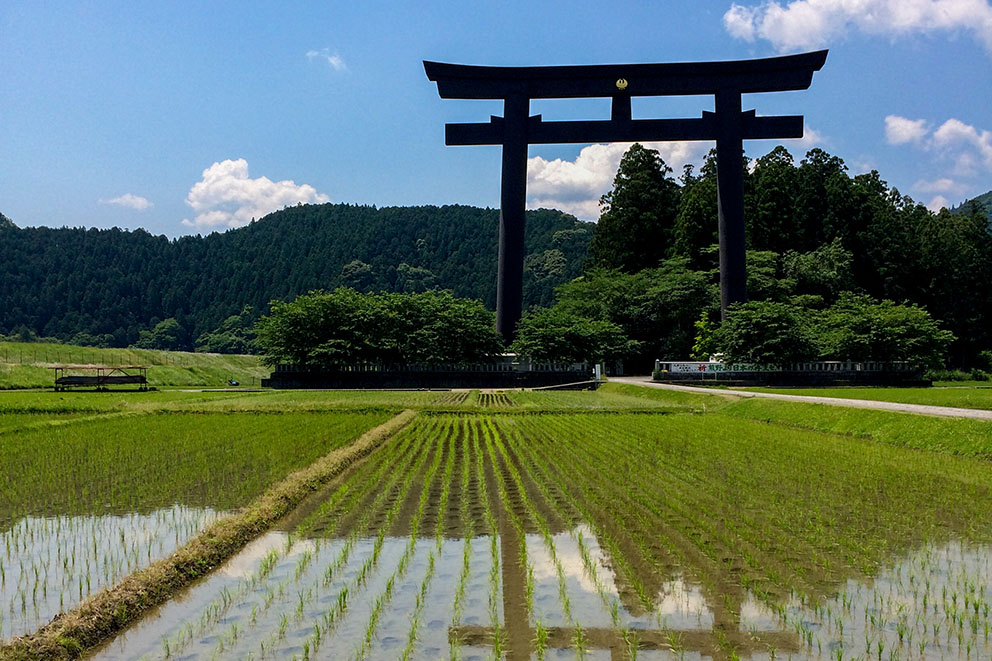
Kumano Hongu Taisha was originally located at Oyunohara, a sandbank at the confluence of the Kumano-gawa and Otonashi Rivers.
Legend has it that the Kumano deities, in the form of three moons, descended into the branches of a giant oak tree in this clearing.
All of the Kumano Kodo pilgrimage routes lead to this sacred site.
The entrance to Oyunohara is marked by the largest Torii shrine gate in the world (33.9 meters tall and 42 meters wide). It is a formalized gateway that designates the entrance to a sacred area and signifies the division of the secular and the spiritual worlds. -
BUS FROM HONGU TO YUNOMINE ONSEN (Nara Kotsu)
Depart: 16:58 Hongu Taisha-mae
Arrive: 17:09 Yunomine Onsen
Busses depart from in front of the Kumano Hongu Heritage Center.
PRICE: 310 yen
NOTE: After the 16:58 bus there is a long wait until the next one. For Saturdays, Sundays and national holidays, the 16:23 bus (not the 16:58) is the best option available.
-
VISIT YUNOMINE ONSEN
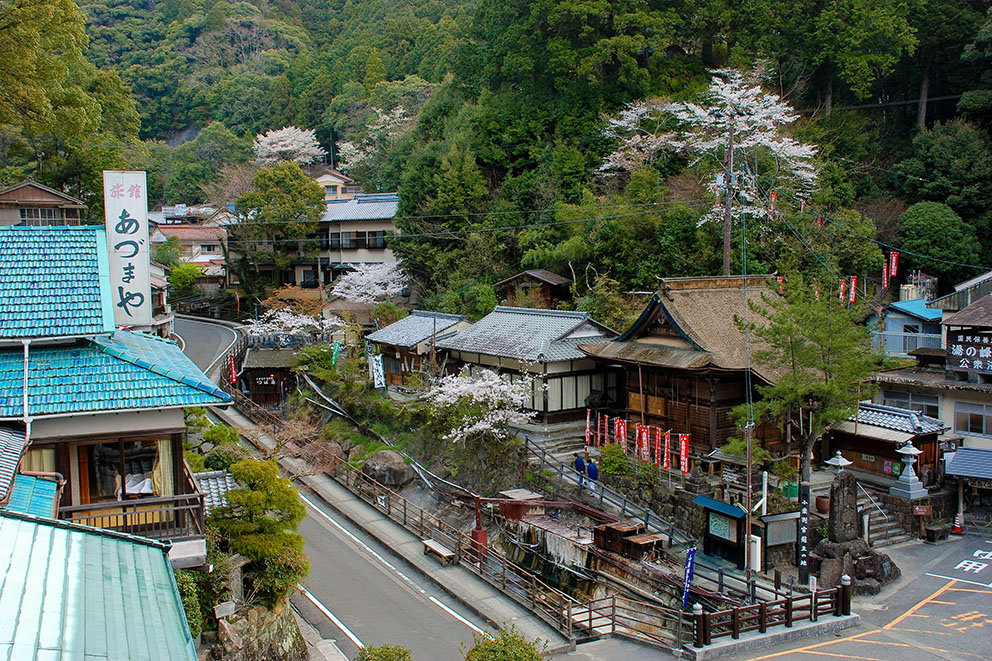
Yunomine Onsen is one of the oldest hot springs in Japan and directly connected with the Kumano Kodo. It is a quaint little collection of inns tucked into a small valley.
Tsuboyu is an historic bath which was used by pilgrims past to purify themselves with the hot water. Tickets are sold at the booth next to the temple.
-
OVERNIGHT IN YUNOMINE ONSEN
There is a diversity of accommodations in Yunomine Onsen such as Ryokan inns, Minshuku lodgings, each with their own hot spring baths.
-
SUPPER
At accommodation.
DAY 4
Traditional Boat Tour, Visit Kumano Hayatama Taisha
Overnight: Katsuura Onsen
-
DAY 4 OVERVIEW
DAY FOUR journeys on the Kumano-gawa on a traditional flat bottom boat retracing the historic Kumano Kodo water pilgrimage route.
Visit Kumano Hayatama Taisha and Katsuura Onsen, a coastal hot spring fishing village famous for its hot springs.
-
BREAKFAST
At accommodation.
PICK UP LUNCH BOX
It is usually easiest to order your lunch box from the accommodation. Book a lunch box plan to take advantage of this service. -
LUGGAGE SHUTTLE
Leave luggage at accommodation.
-
BUS FROM YUNOMINE ONSEN TO BOAT TOUR CENTER
TRADITIONAL BOAT RIDE ON KUMANO-GAWA RIVER
.jpg)
10:00~11:30
Historically pilgrimage travelled by boat between Kumano Hongu Taisha and Kumano Hayatama Taisha.
These tours follows the same route in flat bottom wooden boats.
This is an excellent way to view the spiritual landscape from the river like pilgrims past.VISIT KUMANO HAYATAMA TAISHA
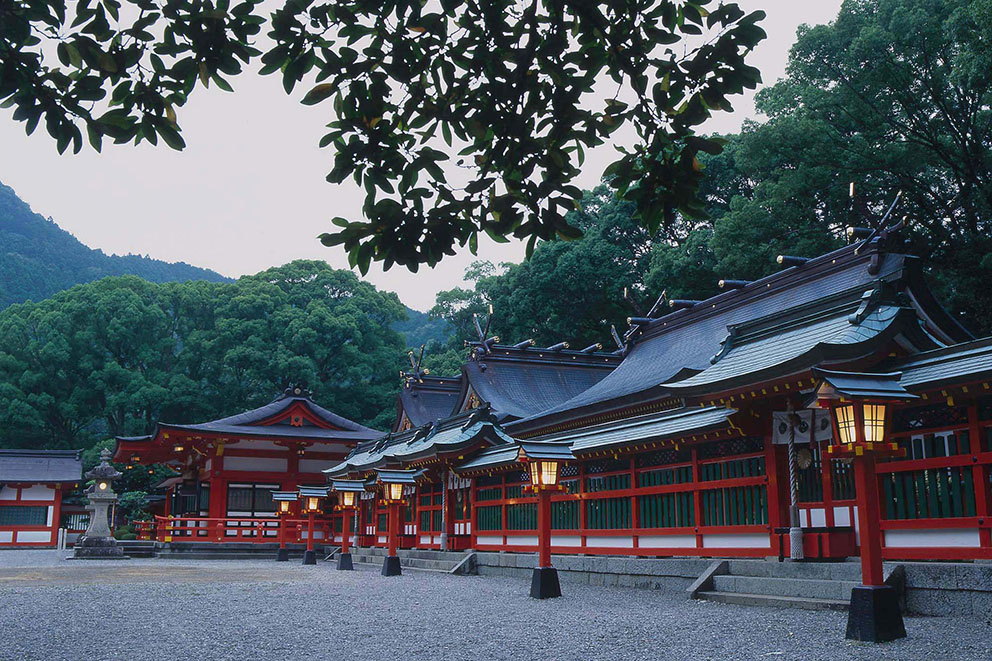 One of the three Kumano grand shrines, Kumano Hayatama Taisha is located at the mouth of the Kumano-gawa river.
One of the three Kumano grand shrines, Kumano Hayatama Taisha is located at the mouth of the Kumano-gawa river.
The bright vermillion colors accent the surrounding forest.
Watch for the ancient Nagi tree whose leaves were used as amulets.
LUNCH
Picnic lunch or at restaurant in Shingu.
TIP: Kamikura-jinja is a nice spot for a picnic lunch.KAMIKURA-JINJA
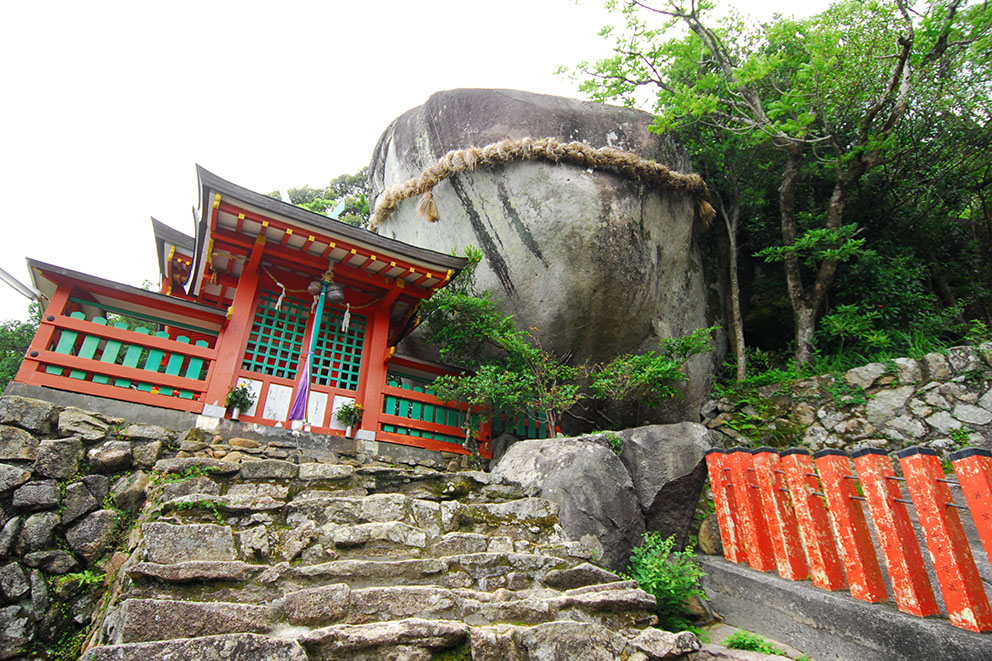 Gotobiki-iwa, a gigantic rock located halfway up Gongen Mountain, is revered as a deity and is the site where the Kumano deities are first believed to have descended.
Gotobiki-iwa, a gigantic rock located halfway up Gongen Mountain, is revered as a deity and is the site where the Kumano deities are first believed to have descended.
At the base of this monolith is a shrine called Kamikura-jinja with views of Shingu.
Option 1
BUS FROM SHINGU TO KATSUURA (Kumano Kotsu)Depart: 15:00 Shingu Station
Arrive: 15:39 Kii-Katsuura Station
PRICE: 630 yen
NOTE: Departures are every 30 minutes. Taking a train is also an option.
Option 2
TRAIN FROM SHINGU TO KATSUURA (JR local)Depart: 15:51 Shingu
Arrive: 16:15Kii-Katsuura
TIP: Sit on the lefthand side of the train for the best coastal views.VISIT KATSUURA ONSEN
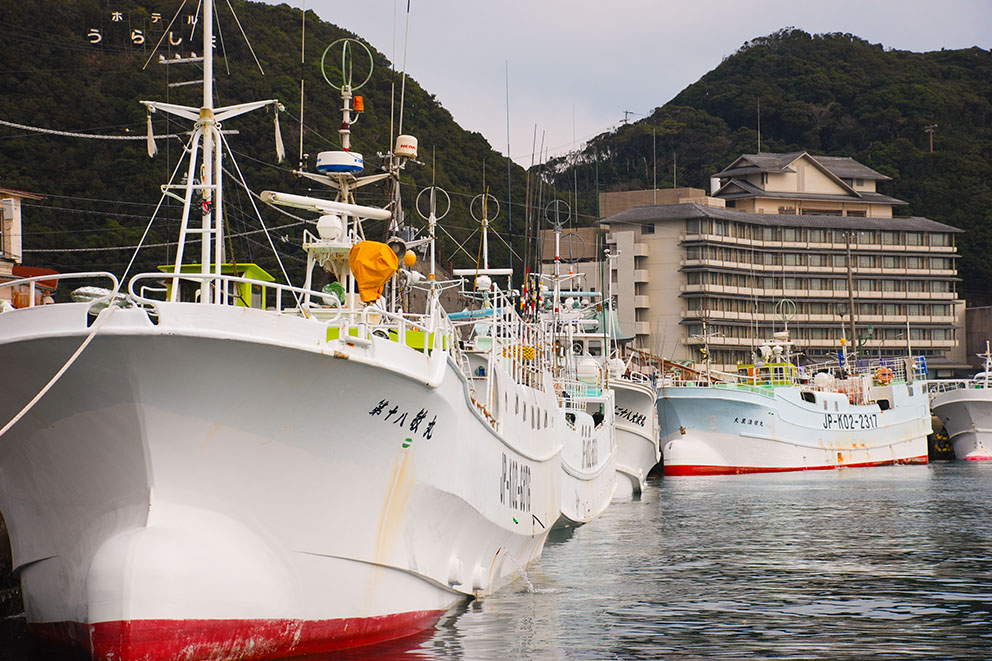 Katsuura Onsen is a fishing port on the rugged Pacific coastline.
Katsuura Onsen is a fishing port on the rugged Pacific coastline.
This coastal village famous for its hot spring baths and world-class seafood.
OVERNIGHT IN KATSUURAThere are a diversity of Ryokan, Minshuku, and Guesthouses in Katsuura, so with coastal views, and many with hot spring baths.
SUPPER
At accommodation.
DAY 5
Visit Kumano Nachi Taisha, Transfer to Next Destination-
DAY 5 OVERVIEW
DAY FIVE is a visit in the morning to the Nachi Shrine-temple complex including a short walk on the scenic Daimon-zaka slope culminating at the Nachi waterfall, the tallest in Japan.
In the afternoon transfer next destination.
-
BREAKFAST
At accommodation.
-
LUGGAGE STORAGE
Leave luggage at accommodation or in the coin lockers next to the Kii-Katsuura station.
-
BUS FROM KATSUURA TO DAIMONZAKA (Kumano Kotsu)
Depart: 8:25 Kii-Katsuura
Arrive: 8:44 Daimonzaka
PRICE: 430 yen
NOTE: At Daimonzaka bus stop are toilets and vending machines.
-
WALK KUMANO KODO - DAIMON-ZAKA
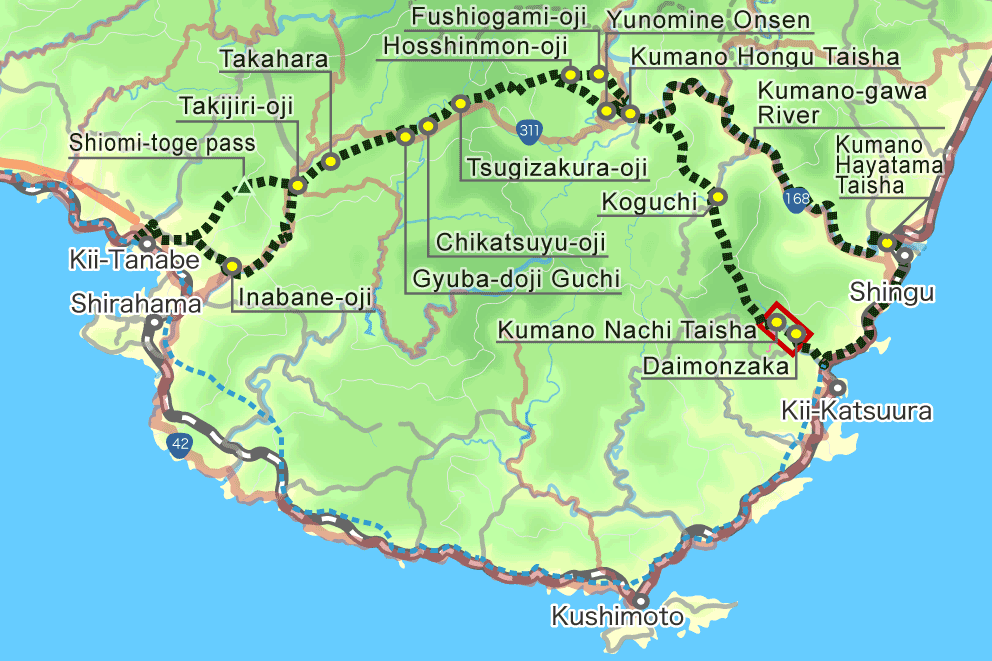
Distance: ~2 km
Time: ~1 hr
Elevation Gain: ~190 m
Elevation Loss: ~460 m
The Daimon-zaka is a short but scenic cobblestone staircase rising out of the valley lined with ancient trees.
NOTE: The distance and time above is only from the base of the valley to the Shrine-temple complex. There is more descent to the waterfall base and Nachi-no-Taki-mae bus stop. -
VISIT KUMANO NACHI TAISHA
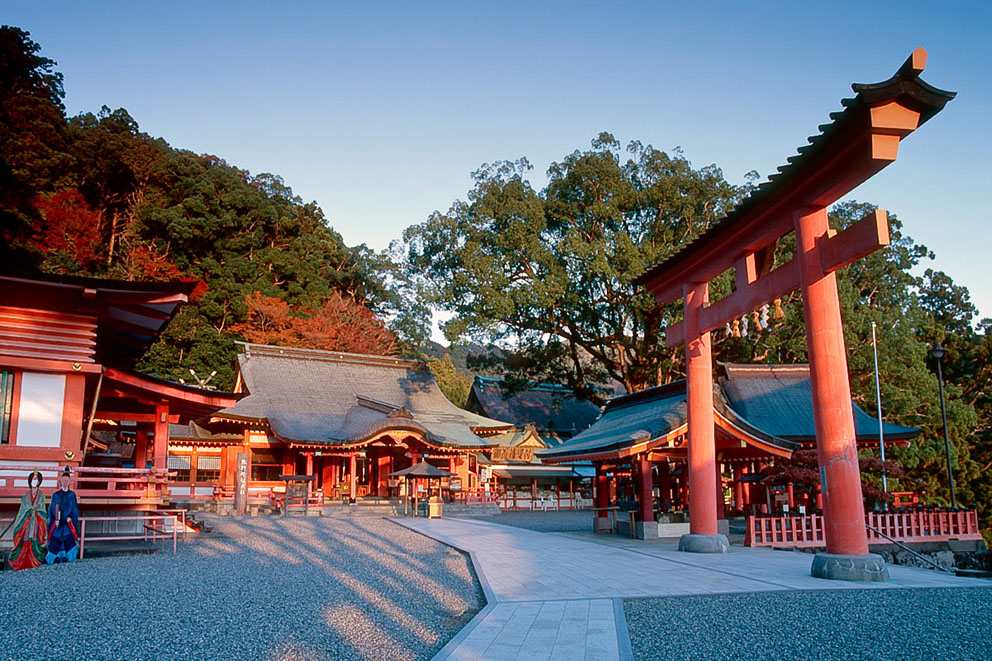 One of the three grand shrines, Kumano Nachi Taisha is located halfway up Nachi Mountain, about 350 meters above sea level.
One of the three grand shrines, Kumano Nachi Taisha is located halfway up Nachi Mountain, about 350 meters above sea level.
It has its religious origin in the ancient nature worship of Nachi-no-Otaki falls.
The branches of a giant camphor shades the roof of the worship hall.
-
VISIT SEIGANTO-JI
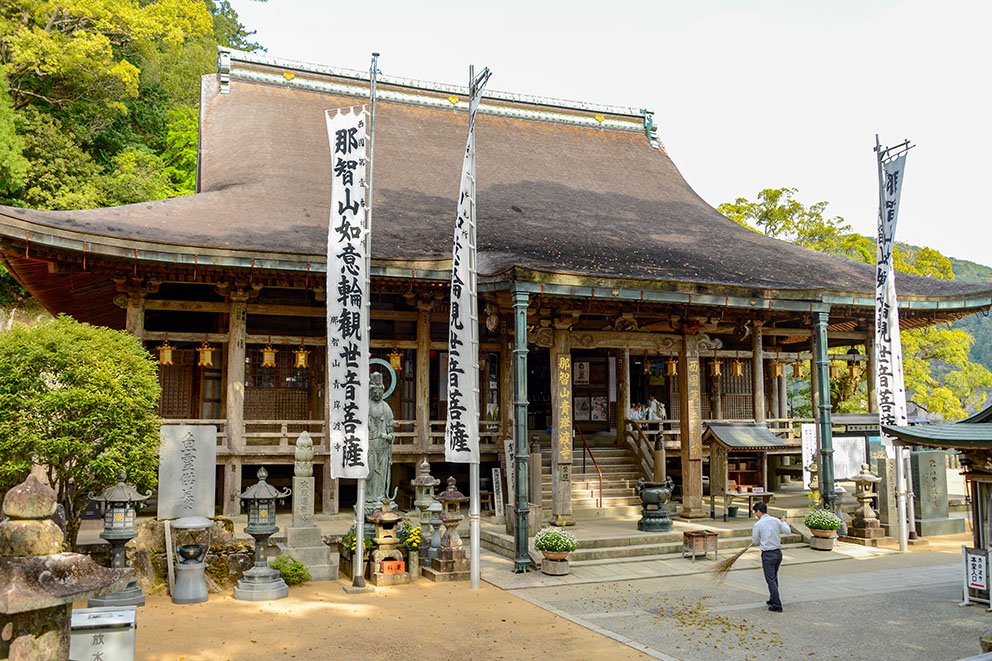 Seiganto-ji temple was founded in the early 5th century and is one of the oldest buildings in the region.
Seiganto-ji temple was founded in the early 5th century and is one of the oldest buildings in the region.
The view from the temple grounds is dramatic, featuring a pagoda with the falls as a backdrop.
-
VISIT NACHI FALLS
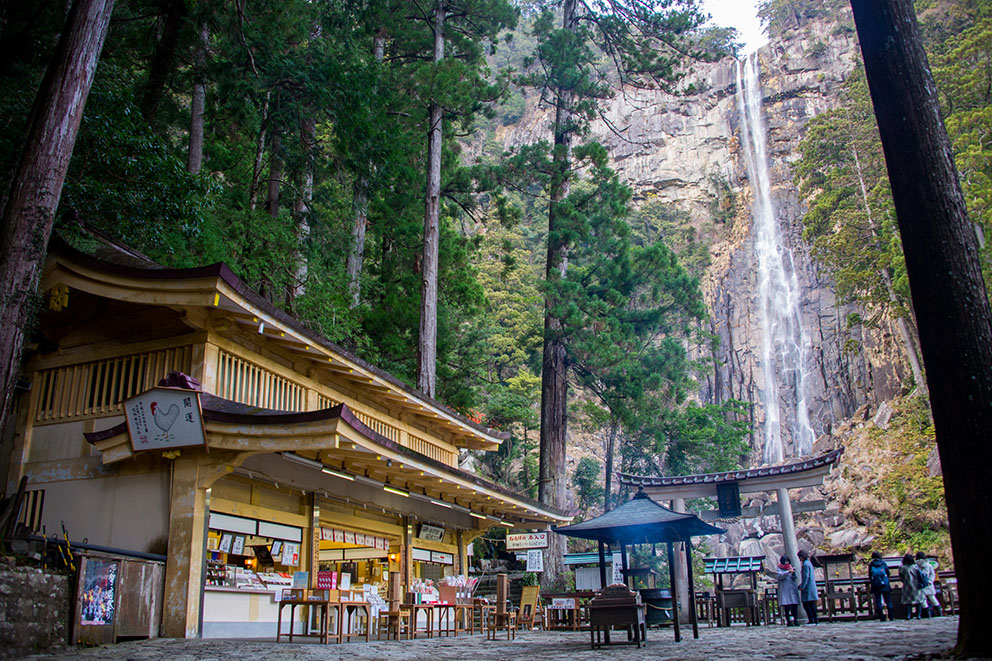 Nachi-no-Otaki is 133 meters high and 13 meters wide - the tallest waterfall in Japan.
Nachi-no-Otaki is 133 meters high and 13 meters wide - the tallest waterfall in Japan.
It's water source is the surrounding broad-leaf evergreen primeval forest, a sanctuary that has been protected since ancient times, used for ascetic training by mountain monks who practice Shugendo, a mixed religion of foreign and indigenous beliefs.
-
BUS FROM NACHI TO KATSUURA (Kumano Kotsu)
Depart: 11:44 Nachi-no-Taki-mae
Arrive: 12:08 Kii-KatsuuraPRICE: 630 yen
-
LUNCH
There are a diversity of small restaurants near the station. Ask at the tourist information office in the Kii-Katsuura station.
-
TRAIN FROM KII-KATSUURA TO OSAKA (JR Kuroshio 26)
Depart: 13:46 Kii-Katsuura
Arrive: 17:53 Shin-Osaka
TIP: Sit on the lefthand side of the train for the best coastal views. -
OTHER OPTIONS
There are a few options after the trek including the following:
1. Staying another night in the Katsuura area to enjoy some downtime to recuperate from the walk.
2. Head east up the coast towards Ise and Nagoya.
3. Stay in Kushimoto area to enjoy the rugged coast line.
